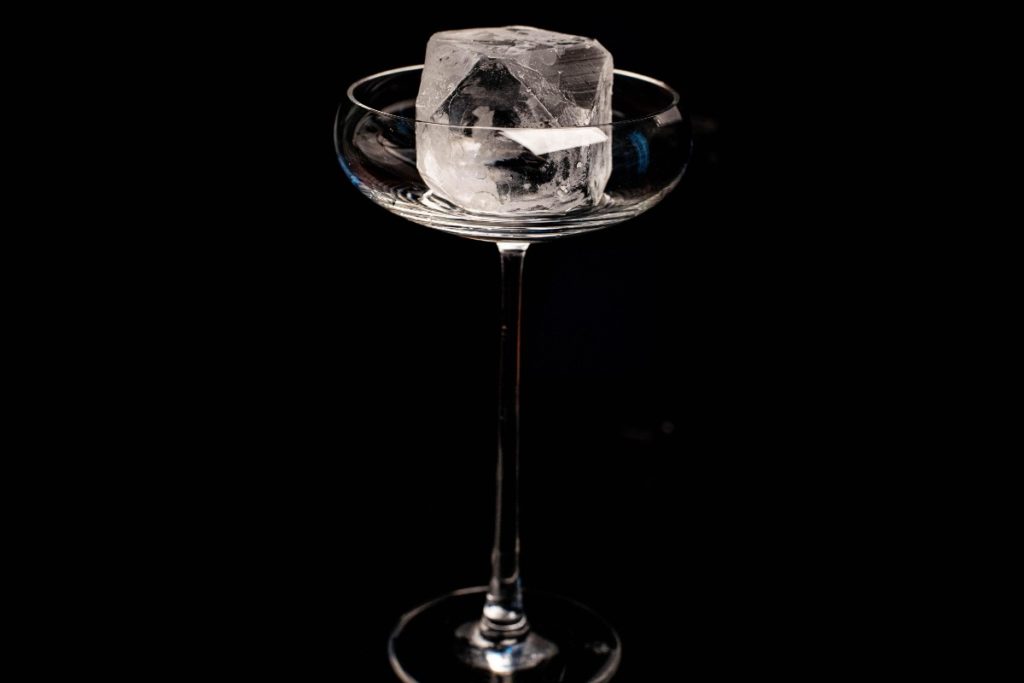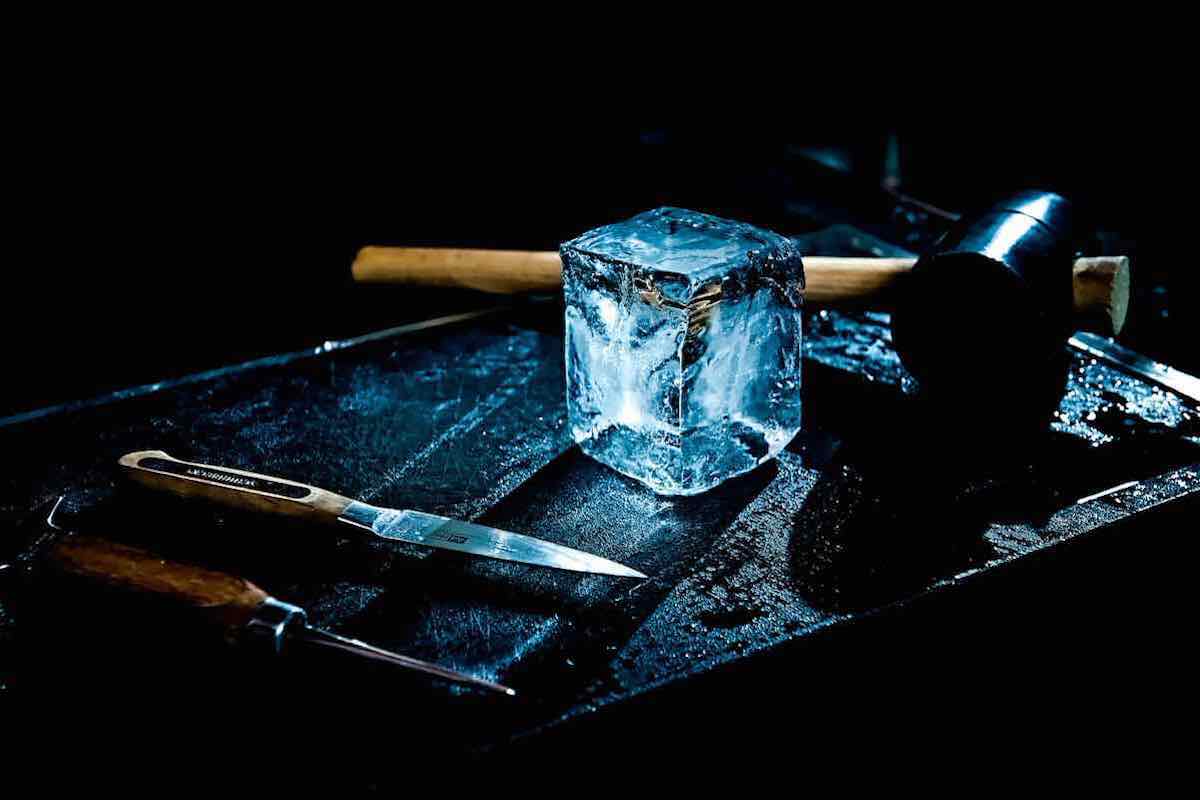In a previous post, I covered how to make clear ice at home, along with some tips on cutting ice slabs into cubes. Today we’ll take a closer look at ice cutting tools for breaking down blocks and shaping ice.
Professional craft cocktail ice makers in the U.S. typically use a Clinebell ice machine to make large, 300-pound blocks of ice meant for ice sculptures. They then cut these blocks into cubes using a band saw and sometimes also an electric chainsaw. In this post, we’ll skip the power tools and concentrate on hand tools recommended by bartenders.
Lumber Saws Are Good For Ice Blocks, Too
Some bar operators purchase the large ice sculpture blocks (rather than make them themselves) and cut them up with hand tools into smaller blocks, and then later into cubes. There is a type of ice saw used in Japan (Japanese bar tools as well as ice tools are generally well-regarded) with large teeth and a straight handle. Large saws can sell for hundreds of dollars.
Iruma Shibuya, who works at Backbar in Somerville MA, and with the catering and educational events team at The Cocktail Guru, interned at Tokyo’s famous Bar High Five. The bar’s owner Hidetsugu Ueno is world famous for his work with ice, particularly in carving ice diamonds. Shibuya didn’t need such large ice saws in Japan as the blocks that were delivered to the bar were smaller, but he does in Boston where the bar starts with larger (50 pound) initial blocks.
Shibuya says, “These ice saws are made to have the tips of each tooth to slightly flare outwards so that as one cuts ice, the ice chips and water get pulled out of the channel rather than getting caught in the block. This helps speed up the cutting process, and there are less opportunities for the ice chips and water to gunk up and refreeze in the channel around the saw while one cuts ice.”
These ice saws start at huge sizes, but if you’re mostly cutting up ice made at home in a beer cooler, you can buy something with a blade that measures about 10 to 12 inches. Ice saws are often based on (or actually are) saws used for cutting wood. If you search online for “Japanese ice saw,” you’ll likely see various woodworking saws, tree limb saws, timber saws, and pruning saws. Chris Morris, beverage director at Aya Sushi & Kau Ba Saigon Kitchen in Houston, prefers a less expensive Japanese crosscut timber saw.

Liam O’Brien, a former chef and current owner of Brass Monkey in Nottingham, says that “tree surgery tools are great and built to last, and do heavy work. Those saws have replacement blades, too.” He owns a few tools good for cutting up blocks and slabs, including a pruning saw and a butcher’s cleaver.
Leave It to Cleavers
Keep in mind that with ice blocks and slabs made in a home cooler, most of the time you’ll only need to score a line across the surface of the ice rather than saw through the entire block, then tap on it with a (usually wooden) mallet to split it. Thus, many bartenders prefer a saw with a back that is straight, rather than curved.
Both cleavers and soba knives may have nice flat backs, but they do not have teeth like saws. Both types of knife can be used to score lines in slabs of ice, as well as for “shaping” ice, including straightening sides of cut blocks and cubes.
Shibuya notes that when splitting blocks of ice, a saw with teeth, or one with a rounded back, can split unevenly since the blade doesn’t rest with equal pressure along the ice. He has used and recommends soba knives. He says, “The Soba Knife we used is made of stainless steel instead of iron, and it was not the most expensive or impressive blade. The focus was to find a single sided blade with a straight edge that wasn’t too thick and could weather being wet without rusting. The most important part of using the soba knife is that you have a wide and consistently straight edge that touches the entire surface of the ice you are trying to cut.”
Professional knife maker Adam Simha of MKS Custom Knives made knives especially for the Boston bar Drink, where bartenders cut ice off a large block during service. One large cleaver-style knife Simha made for the bar was rectangular in shape and heavy duty in construction. He says, “General manager John Gertsen asked that I make a knife to replace the inexpensive Chinese cleavers they’d been using (and regularly breaking). It can shape, shave, crush, and in conjunction with a mallet, split and cleave.”
As mentioned in my previous post on cutting up a slab of ice, you can simply use a serrated bread knife to do the trick at home. Bread knives often have good-sized teeth and a flat back, plus they’re inexpensive. Similarly, Liam O’Brien uses a serrated pastry knife from Victorinox, which he says is more versatile. “It’s perfect for a directionally frozen block in the mini [cooler] but can also work on bigger blocks. And it’s great for trimming smaller blocks into shapes, carving, etc.”
In her book The Way of the Cocktail, Julia Momose says that she prefers the small, flat-backed Japanese machete called a nata. It’s a bread knife in shape but without a serrated edge.
Fine Tuning: Picking and Paring
After your block has been broken down into a smaller size, you can cut it into a perfect cube, carve an ice diamond, or hand-carve an ice ball. There are plenty of instructional videos on YouTube on how to cut ice like the pros. You’ll notice that the bartenders use a variety of different tools based on personal preference.

Three-prong ice picks can be used to break up big cubes into smaller ones, or to chip ice spheres by hand. Javier Flores, founder of Fat Ice Company, has two different three-pronged ice picks that he uses depending on the number of ice balls he is carving. He says, “The large pick is weighted better, but if I’m going to be doing more than a dozen or if I’m going to make smaller spheres, I will use the [smaller, inexpensive, and easy to find] Deluxe model.”
Many people who hand-cut ice prefer to use some version of a paring knife. A paring knife is a short-bladed non-serrated knife that can be used for peeling fruit and vegetables but is an all-purpose small knife. Paring knives come in many different lengths and shapes. Adam Simha designed a paring knife for Ezra Star (formerly of Drink in Boston). It looks a bit like a small machete with flat edges both along the bottom as well as the tip of the knife (called a “tanto tip”). He says that the small tanto shape was made specifically to carve shapes from a big cube while holding the cube with one’s hand. “The knife will dive slightly into the ice as opposed to skipping out and into fingers.”
Momose prefers a Japanese boning knife called a “honetsuki.” It is similar to a paring knife with a triangular shape. Shibuya also used this style of knife at Bar High Five and says, “For shaping, this boning knife is very helpful because the blade was made to deal with hard materials, unlike the soba knife. The chicken boning knife is also a single sided blade and that helps maintain a clean cut.”
Flores of Fat Ice says he can use either a large paring knife or a decent quality chef’s knife (a larger, non-serrated, all-purpose knife) for cutting diamonds and other shapes. “Premium Japanese knives are nice, but the abuse I put them through hand cutting for events doesn’t really make sense. I like the Dalstrong brands just fine.”
Chisel It, Just a Little Bit
“The most valuable tool in the arsenal for clean cubes is a good oire nomi,” says Chris Morris. That’s the term for a Japanese wood chisel. Morris says that it is “great for individual sectioning and particularly useful for diamonds.”
Merlin Griffiths, who calls himself a “publican and TV bartender” suggests looking for a chisel with a flat side and a beveled side, not like a wedge that’s used to split logs. “A standard knife is honed from both sides of the cutting edge. But this knife is very thick and only honed to an edge from one side, much like a woodworker’s chisel would be.” His model has a four-inch long edge, and Griffiths says it is great for shaping ice.

Despite all the fancy equipment that Shibuya owns and works with, he offers some practical advice for people with limited access to tools and resources. “I would suggest using a wooden mallet and two-inch chisel, and to cut the blocks in a primal manner. ‘Primal’ as in cutting the block in half, then another half, etc., until the size of cubes desired are obtained. Shaping and cleaning can also be achieved with the chisel, and most of all, the chisel’s blade is single sided, which helps to get clean cuts.”
An Unexpected Hack
Mihai Fetcu, Creative Director of Bar D.O.M.E in Romania, says he found the best—and certainly least expensive—knife for the job of cutting cubes and diamonds after working with ice on a daily basis for more than five years. He says, “The Japanese stuff I keep for exhibitions, shows, competitions, training, etc., where I just show off.”
Behind the scenes when he is cutting ice to serve later, rather than in front of patrons, he opts for a very generic utility knife (sometimes called a box cutter). “I own and have tried all sorts of Japanese bar tools and they are good if you have to make one [ice diamond]. If you have to make a lot, then the grip is killing your hand slowly but steadily. The easiest, fastest, safest way to carve ice is with a metal cutter,” he says.
“They are very cheap, but the blade wears off rather quickly. On a normal day, where I process around 200 to 500 individual pieces, I use three to four [of these cutter tools], depending on the model. When I’ve had to get a job done, the cutter has been my friend.”
Camper English is the author of The Ice Book: Cool Cubes, Clear Spheres, and Other Chill Cocktail Crafts.



